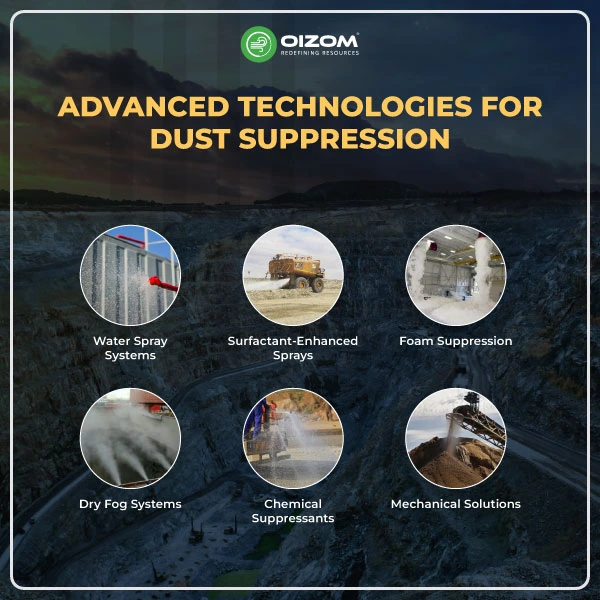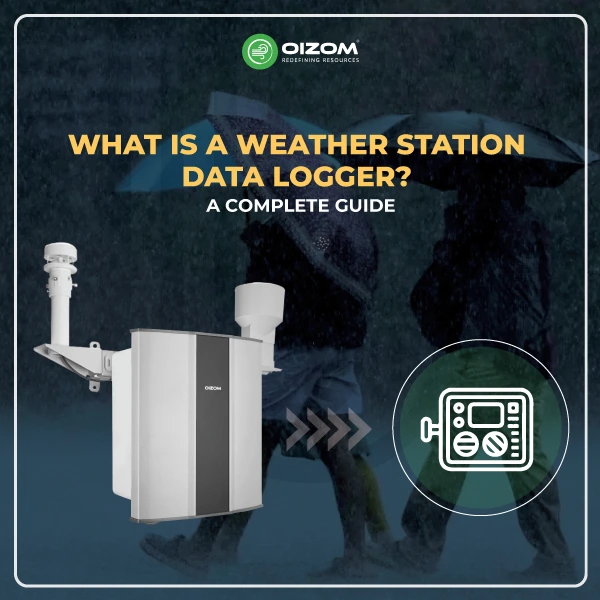TL: DR
Dust control has evolved way beyond water spraying. Today’s industries use high-tech solutions like dry fog systems, surfactant-enhanced sprays, foam, chemical suppressants, and even IoT-powered automation to tackle dust more effectively. These systems adapt in real-time to wind, humidity, and dust load, cutting down water use and boosting efficiency.
Whether you’re in mining, construction, or material handling, picking the right dust suppression method depends on your dust type, site conditions, and environmental goals. Want long-term control? Chemical binders or polymers work well. Need minimal moisture? Go for dry fog or mechanical solutions like enclosures and LEV.
Real-time air quality monitors like Oizom’s Dustroid help trigger suppression only when needed, saving resources and ensuring compliance. The future? Think predictive AI systems and sustainable, biodegradable suppressants. It’s all about cleaner air, safer workplaces, and smarter operations.
Bottom line: Dust suppression isn’t just about visibility. It’s about health, safety, and sustainability. And with the right tech, it’s easier than ever to stay ahead of the dust.
Advanced Technologies for Dust Suppression
Dust suppression isn’t just about spraying water anymore. Today, it’s a blend of smart engineering and innovative tech that helps industries tackle dust more effectively and more sustainably. Whether you’re in mining, construction, or bulk material handling, controlling airborne particles is key to staying compliant, protecting worker health, and keeping your operations running smoothly.
In this blog, we’ll explore the advanced technologies that are changing how dust is managed. From high-pressure mist cannons and fog systems to chemical suppressants and electrostatic solutions, the focus is now on precision and automation. These systems are designed to respond in real-time, factoring in wind speed, humidity, and dust load to optimize performance.
We’ll also touch on the rise of IoT-based dust suppression systems that allow remote monitoring and control, bringing data-driven decision-making to the field. Plus, innovations like biodegradable surfactants and nano-based dust binders are pushing the boundaries of what’s possible in sustainable dust control.
If you’re looking for technical yet practical insights into modern dust suppression, you’re in the right place. Let’s dive into the smart solutions, making dust control cleaner, smarter, and more efficient.
Understanding how dust suppression works
Dust suppression might seem straightforward, but there’s actually a lot of science and engineering behind it. At its core, dust suppression involves capturing or preventing airborne particles before they spread, especially in industries like mining, construction, waste handling, and bulk material transport.
So, how does it work?
The basic principle is to increase the weight of dust particles so they can’t stay suspended in the air. This can be done using water, chemicals, or even electrostatic forces. The most common method is water-based suppression, where fine droplets, created using nozzles, mist cannons, or fogging systems, attach to dust particles. These heavier combined particles then settle to the ground.
But it doesn’t stop there. Modern systems go beyond just spraying water. Advanced technologies now use surfactants and binding agents to improve droplet-to-dust adhesion. These additives lower the surface tension of water, allowing it to “grab” finer dust more effectively. In dry or windy environments, polymer-based sealants or foaming agents are used to form a crust over dust-prone surfaces, offering long-term control.
IoT-enabled systems also play a role by automating suppression based on real-time dust levels, wind direction, and humidity, making the process smarter and more efficient. For instance, at the Joda East Iron Mine, TATA Steel installed Oizom’s Dustroid to monitor particulate matter continuously. With real-time insights, the team can now identify dust hotspots, trigger suppression systems only when needed, and reduce unnecessary water or chemical usage, cutting down operational costs while ensuring worker safety. Want to see how it worked in action? Check out the full case study to explore the
Understanding how dust suppression works isn’t just about controlling particles, it’s about combining physics, chemistry, and smart tech to protect people, equipment, and the environment.
Types of Dust Suppression Technologies
In high-dust environments like mining, construction, or bulk material handling, dust suppression isn’t just good practice; it’s essential. Uncontrolled dust affects worker health, visibility, equipment lifespan, and compliance with environmental norms. Thankfully, there’s no one-size-fits-all approach; industries today have access to a range of technologies specifically for different operational needs. Let’s explore the most commonly used dust suppression methods, their technical principles, and where they work best.
1. Water Spray Systems
This is the most widely adopted and cost-effective method. It works on a simple principle: spraying water to increase the weight of airborne particles so they settle more quickly. But it’s more than just spraying water; system efficiency depends on droplet size, spray angle, water pressure, and nozzle placement. For example, too much water can make materials overly wet, affecting processing, while too little won’t trap enough dust.
Water spray systems are often installed at transfer points, conveyor belts, crushers, and loading zones. They’re ideal for environments where dust generation is constant, and water usage isn’t a major concern.
2. Surfactant-Enhanced Sprays
When plain water isn’t enough, especially with fine, hydrophobic dust, adding surfactants makes a big difference. Surfactants reduce water’s surface tension, helping droplets spread and bind more effectively to dust particles. This is particularly useful in coal mines, cement processing, or dusty warehouses where ultra-fine particles are difficult to control.
This method not only boosts dust capture but also reduces water consumption. However, care must be taken to use biodegradable and environmentally safe surfactants, especially in ecologically sensitive areas.
Since the 1960s, surfactants have been used in water sprays to improve dust suppression, especially in coal mines. By reducing water’s surface tension, surfactants help it better stick to and trap fine dust particles. Did you know this? Field studies have demonstrated that combining surfactants with polymers can reduce respirable dust levels by approximately 40% to 60% compared to using water alone.
However, their effectiveness isn’t universal, and it can vary based on the type of coal, particle size, and site conditions. That’s why it’s important to test and tailor surfactant solutions for each location.
3. Foam Suppression
Foam-based systems are another effective method, especially in high-impact areas like crushers and screeners. These systems mix air, water, and a foaming agent to form a thick, long-lasting foam. The foam traps dust at the source and forms a barrier over material surfaces to prevent dust escape.
Because foam holds its shape and moisture for longer than mist or sprays, it provides extended suppression without excessive water use. It’s ideal where minimal moisture addition is important but dust levels are high.
4. Dry Fog Systems
Dry fog suppression is an advanced method that uses ultra-fine water droplets, typically less than 10 microns in diameter. These droplets are roughly the same size as dust particles, which allows them to collide in the air, agglomerate, and fall due to gravity.
Dry fog systems add very little moisture to the material, making them ideal for applications where water must be tightly controlled, like in cement manufacturing, limestone processing, or fertilizers. Although the initial setup is more complex and costly, dry fog delivers excellent results for moisture-sensitive operations.
5. Chemical Suppressants
Chemical dust suppressants are used where long-term dust control is needed, like on haul roads, stockpiles, or open yards. These include salts (like calcium or magnesium chloride), polymers, and other dust-binding chemicals that are sprayed onto surfaces. Once applied, they form a crust or bind particles together, reducing the chance of dust getting resuspended.
Did you know this? In 2021, the calcium chloride segment accounted for 29.5% of the global dust control systems and suppression chemicals market. It had the largest market share by chemical type.
Chemical suppressants are especially useful in dry or windy environments where water evaporates too quickly. However, environmental impact and application costs should be considered. It’s best to choose eco-safe, non-toxic suppressants, especially in areas close to water bodies or vegetation.
6. Mechanical Solutions
Mechanical dust control methods play a foundational role in stopping dust before it spreads. These systems are designed to contain, capture, or redirect dust right at the source, reducing the need for reactive measures like water spraying or fogging.
Key Mechanical Dust Control Methods
- Enclosures and Covers: Enclosing dust-generating equipment, like crushers, screens, and conveyors, prevents dust from escaping into the air.
- Sealed Conveyors and Transfer Points: Using skirting systems and sealed chutes minimizes dust leakage during material handling and movement.
- Windbreaks and Barriers: Installing physical barriers around open yards or stockpiles helps reduce wind-blown dust, especially in exposed environments
- Local Exhaust Ventilation (LEV): LEV systems capture airborne dust at the point of release, using hoods and ductwork to direct it to filters or dust collectors.
Effectiveness Backed by Data
Mechanical controls aren’t just practical; they’re proven to work.
- A NIOSH study showed that LEV systems can reduce respirable dust exposure by up to 95% during concrete cutting operations.
- A systematic review (PMC) found that combining enclosures with other controls significantly lowers dust levels in industrial settings.
Best When Integrated
Mechanical solutions are most effective when paired with other dust suppression methods:
- Dry Fog Systems: For example, enclosing transfer points and adding a dry fog system can drastically reduce fugitive emissions.
- Real-Time Monitoring: Integrating these systems with air quality monitors allows for data-driven dust control, ensuring suppression efforts are triggered only when needed.
Are you confused about how to measure PM100 accurately? You’re not alone.
Choosing the right dust monitoring device can be challenging, especially when you need reliable data across particle sizes like PM100, PM10, PM2.5, and PM1. But don’t worry, you’re in the right place.
Oizom’s Dustroid is built to deliver highly accurate real-time particulate data, including PM100, something many monitors don’t offer. Wondering how accurate it really is?
The monitors are operated adjacent to a custom-built reference station, a Beta Attenuation Monitor (BAM) housing a U.S. EPA-designated Federal Equivalent Method (FEM), for 72 hours during collocation calibration. This ensures high data accuracy and consistency. Dustroid even demonstrates accuracy in low dust concentrations, showing a strong R² > 0.85 when collocated with Horiba’s FRM.
That means whether you’re monitoring dust at an industrial site, a construction zone, or near sensitive environments, you can trust the data Dustroid delivers. Curious to learn more? Explore how Dustroid can elevate your dust monitoring efforts with dependable, precise, and scalable technology.
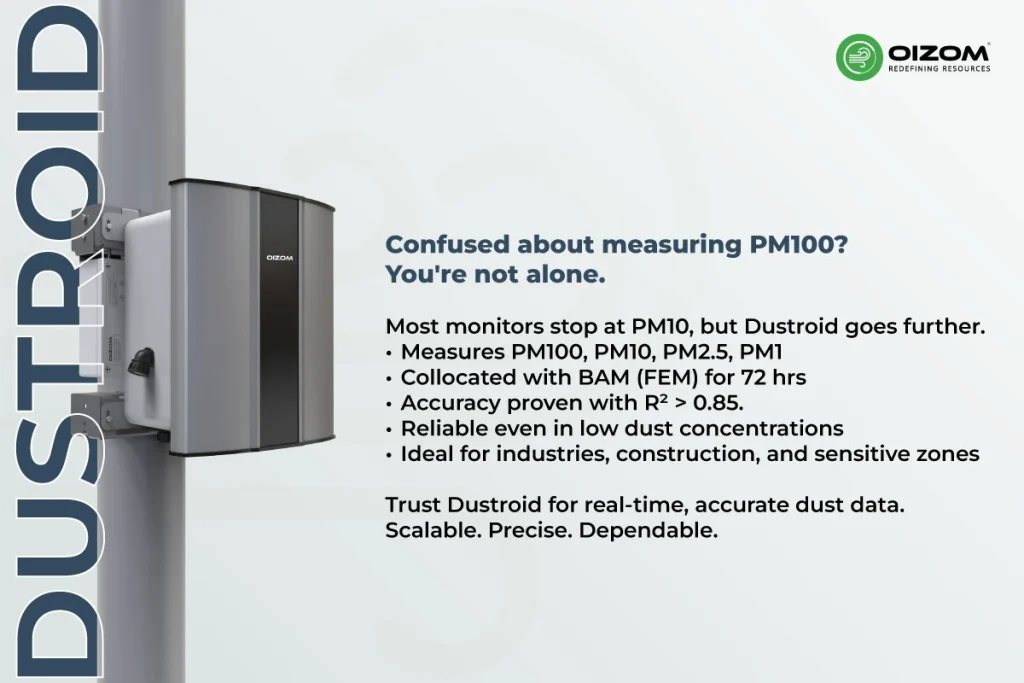
Dust Suppression Methods Comparison Table
| Method | Cost | Efficiency | Best Use Case | Moisture Use |
|---|---|---|---|---|
| Water Spray Systems | Low | Basic | Transfer points, conveyor belts, loading zones | High |
| Surfactant-Enhanced Sprays | Moderate | Moderate to High | Coal mines, cement plants, dusty warehouses | Moderate (Less than water only) |
| Foam Suppression | Moderate | High | Crushers, screeners, high-dust impact zones | Low |
| Dry Fog Systems | High | Very High | Cement, limestone, fertilizer processing | Very Low |
| Chemical Suppressants | Varies (Moderate to High) | High (Long-Term) | Haul roads, stockpiles, dry/windy sites | None (Post-application drying) |
| Mechanical Solutions | Moderate to High | Very High (Source-Level) | Crushers, conveyors, exposed stockpiles | None |
Benefits of Effective Dust Suppression
When it comes to workplace safety, dust might seem small, but its impact can be massive. That’s why having an effective dust suppression system in place isn’t just smart. It’s essential for protecting long-term health.
- First and foremost, it helps prevent respiratory diseases. Inhaling dust particles over time can lead to serious conditions like asthma, bronchitis, or even pneumoconiosis. Dust suppression systems work by keeping airborne dust levels under control, reducing the amount workers breathe in, especially in high-risk industries like mining, construction, or manufacturing.
- It also helps cut down allergens and irritants. Dust can carry things like pollen, mold spores, and dander, all of which can trigger allergic reactions or irritate the eyes, skin, and throat. Suppressing dust means cleaner air and fewer allergy flare-ups, both indoors and out.
- But it’s not just about the physical effects. Cleaner air leads to a more comfortable, mentally healthier workplace. Less dust means better visibility, smoother-running equipment, and fewer distractions, reducing stress and improving overall job satisfaction.
In short, effective dust suppression protects more than the lungs. It supports a safer, healthier, and more productive work environment for everyone on site.
When is the best time to apply dust suppressants?
The timing of dust suppressant application can make a big difference in how effective it is. Ideally, the best time to apply dust suppressants is before dust levels peak, not after. That means getting ahead of dry, windy conditions or high-traffic periods when dust is most likely to become airborne.
For outdoor areas like construction sites, mining roads, or stockpiles, it’s smart to apply suppressants during the early morning or late evening. Cooler temperatures and lower wind speeds help the suppressant settle better and last longer. Avoid using during high heat or strong winds, as they can reduce coverage and effectiveness.
It’s also important to reapply suppressants regularly, depending on weather, site activity, and the type of suppressant used. Some chemical binders offer longer-lasting coverage, while water-based options may need more frequent application.
In short, the key is to be proactive. Monitor dust levels, weather forecasts, and site conditions to schedule applications at the right time. Regular, well-timed treatment controls dust, ensuring a safer, cleaner, and more compliant work environment.
How often should dust suppressants be applied?
The frequency of dust suppressant application depends on a few key factors: such as type of suppressant, site conditions, dust levels, and weather.
Water-based suppressants typically need to be applied daily or every few days, especially in hot, dry, or windy environments where water evaporates quickly. These are ideal for short-term control but require more frequent reapplication.
Chemical suppressants, like polymers or chlorides, last much longer, often weeks to even months, depending on the material, surface preparation, and traffic intensity. For example, a magnesium chloride solution applied on an unpaved road might last 2–4 weeks under moderate use.
High-traffic areas, loose soils, or sites with fine particulate matter (like PM2.5 or PM10) may require more frequent treatments, while compacted surfaces with good binder coverage may hold up longer.
In short, there’s no one-size-fits-all answer. The key is to assess conditions on-site and choose the right suppressant and the right schedule for consistent, effective dust control.
Choosing the Right Dust Suppression Method
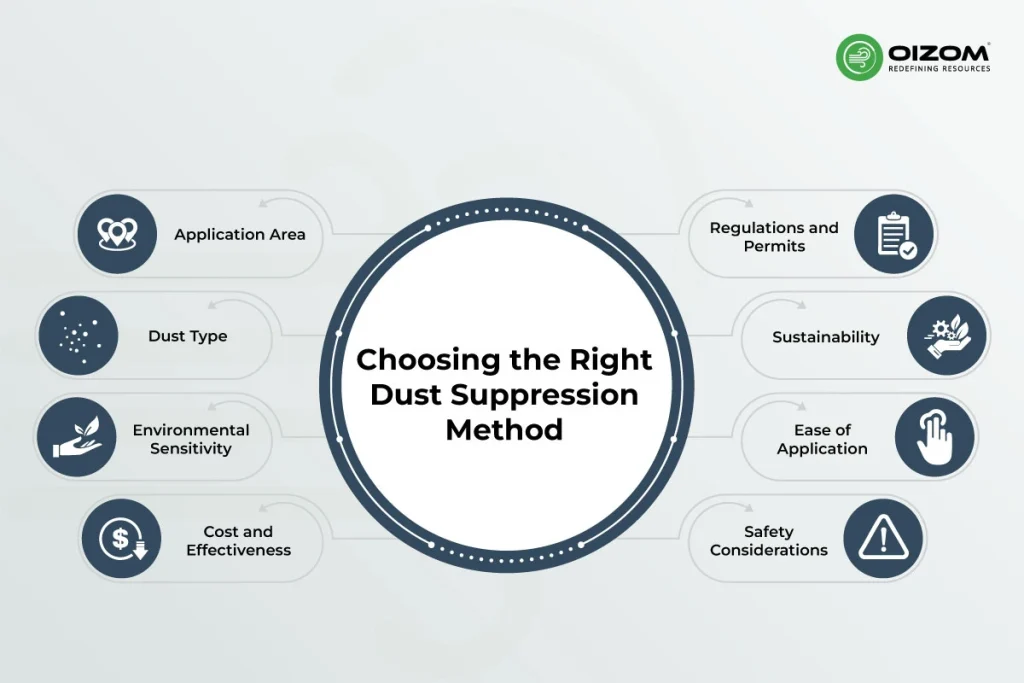
Dust and airborne particles are common results of industrial activities. Effective dust suppression is critical in the rock, sand, gravel, and mineral processing sectors, where airborne dust can cause health dangers, equipment damage, and regulatory compliance issues. Fortunately, today’s dust suppression alternatives range from dry containment strategies to wet suppression technologies such as misting guns.
Selecting the appropriate dust suppression equipment ensures a safe and productive working environment. Below, we will look at the most important things to consider when choosing the best dust suppression equipment for your needs.
- Application Area: Identifying the correct causes of dirt technology in your commercial operation is the first step in selecting the proper dust suppression gadget. Different tactics generate various types and portions of dust. Understanding these resources assists you in picking the right device to go to the troubled regions.
- Dust Type: Not all dust is the same; home know-how is essential in selecting the perfect device. Dust debris’ size, density, and makeup decide how they scatter and settle. Carefully examining the dust will let you choose the only dirt suppression approach, including fogging systems, mist cannons, or dirt creditors.
- Environmental Sensitivity: When purchasing a dust suppression system, environmental factors must be considered. Choose environmentally pleasant generation and water-based or filtration systems to ensure low emissions. Reducing the environmental effect of dirt suppression techniques is consistent with environmentally accountable commercial enterprise operations and regulatory compliance.
- Cost and Effectiveness: While fine and efficacy are vital, budgetary limits must also be considered. Compare the initial buy price, renovation costs, and potential electricity usage of various dust suppression system alternatives. Strive for the proper stability of finances and performance to make an informed choice that fits your budgetary constraints.
- Regulations and Permits: Worker safety is critical in every industrial setting. Select dust suppression equipment that meets with applicable authorities’ safety norms and regulations. Safety features such as automated shut-off systems, emergency stop buttons, and remote monitoring can improve overall operation safety.
- Sustainability: Adopting sustainable dust suppression practices is essential. Organic options like lignosulfonate wood pulp derivatives offer a greener alternative. These biodegradable polymers are both cost-efficient and eco-friendly, aligning with the environmental consciousness of our times. Though more enduring and potent in dust suppression, synthetic polymers are an investment in longevity with a higher initial cost.
- Ease of Application: Consider user-friendly solutions that require minimal training for efficient operation. Because industries and processes are constantly changing, it is critical to select equipment that is flexible and adaptable. Consider adjustable nozzles, variable flow rates, and modular designs that can be readily integrated into your current setup or adapted for future expansion.
- Safety Considerations: Safety must come foremost. The suppression solution should not add new risks. Wet systems require efficient drainage to eliminate slide dangers, while chemical suppressants necessitate defined safety standards and personal protective equipment. Always put worker safety first in your decision-making.
Categorizing Dust Sources
Classifying Dust-Generating Activities: To choose the right suppression strategy, it’s essential to understand the source of dust. Dust emissions are typically classified into:
- Material Handling: Dumping, transferring, loading, or conveying raw materials like ores or coal.
- Storage & Stockpiles: Wind erosion from open storage piles.
- Material Processing: Crushing, grinding, screening operations.
- Unpaved Roads & Surfaces: Dust stirred up by vehicular or foot traffic.
Each source demands a specific solution, e.g., water misting at crushers, chemical stabilizers on haul roads, or enclosures at transfer points.
Industry-Specific Use Cases
- Mining: Long-haul roads often require polymer or chloride-based chemical binders to reduce PM10 emissions, especially in arid zones. Fogging systems at crushers and conveyor junctions reduce localized dust at the source.
- Construction: Frequent movement of soil, cutting, and demolition demand LEV systems, high-pressure mist cannons, and foam applications during demolition.
- Ports & Bulk Terminals: Wind fencing, hooded conveyors, and foam barriers help prevent fugitive dust from escaping into nearby residential zones.
- Waste Management Sites: Odour and dust often co-exist; hence, a hybrid suppression system with deodorizing fog and PM monitors works best.
10 Questions to Ask Before Choosing a Dust Suppression System
Choosing the right dust suppression method requires a clear understanding of your site’s unique challenges. Use this checklist to guide your decision-making and ensure your chosen solution meets both operational and environmental goals.
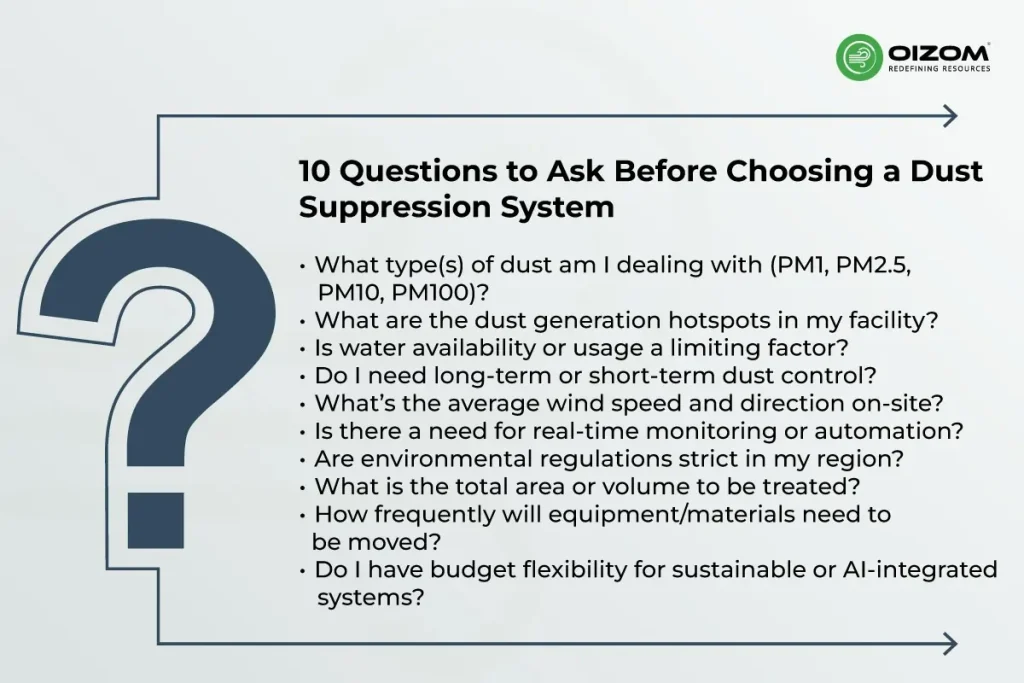
Tip: Review this list with your operations or EHS team to make informed, cost-effective, and compliant decisions.
Conclusion
As we’ve seen, dust suppression today is far more advanced than simply spraying water around. From high-efficiency dry fog systems and surfactant-enhanced sprays to real-time monitoring and IoT-driven automation, the technologies now available allow for smarter, more targeted, and cost-effective dust control.
The key takeaway? There’s no one-size-fits-all solution. Choosing the right technology depends on dust type (PM1 to PM100), source points, environmental conditions, and industry needs. Sites dealing with fine particulate matter may benefit from dry fog and chemical binders, while mechanical systems and local exhaust ventilation work best for source-level control. When precision matters, integrating real-time data from air quality monitors ensures timely, automated response, reducing waste and improving efficiency.
Looking ahead, the future of dust suppression lies in predictive systems powered by AI and machine learning. These technologies will help forecast dust events before they happen, optimize suppressant usage, and support regulatory compliance with minimal human intervention. Sustainable, low-water solutions and biodegradable additives will also continue to gain ground as environmental regulations tighten.
In short, investing in the right dust suppression tech today not only improves worker safety and air quality but also sets the foundation for smarter, cleaner, and more resilient operations tomorrow.
FAQ
The ideal time is before dust levels spike. Apply early in the morning or late in the evening to avoid strong winds and high temperatures, which can reduce the effectiveness of the suppressant.
It depends on the type of suppressant and site conditions:
- Water-based: Daily or every few days (short-term control)
- Chemical suppressants: Every 2–4 weeks (long-term control)
High-traffic or dry zones May require more frequent reapplication
Always monitor weather and site activity for the best schedule.
Yes! IoT-enabled systems (like those connected with Oizom Dustroid) trigger suppression based on real-time PM data, weather conditions, and activity levels, saving resources and ensuring timely action.

